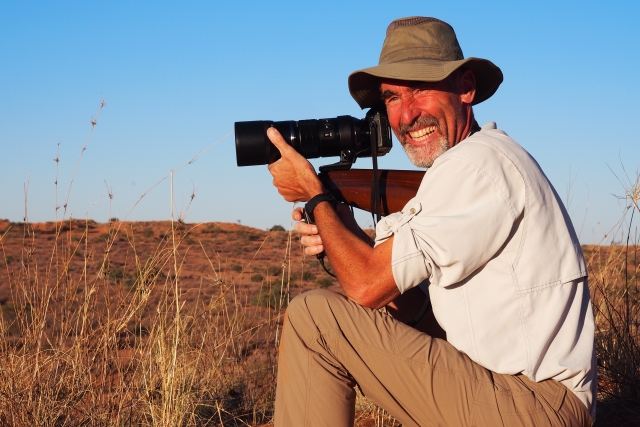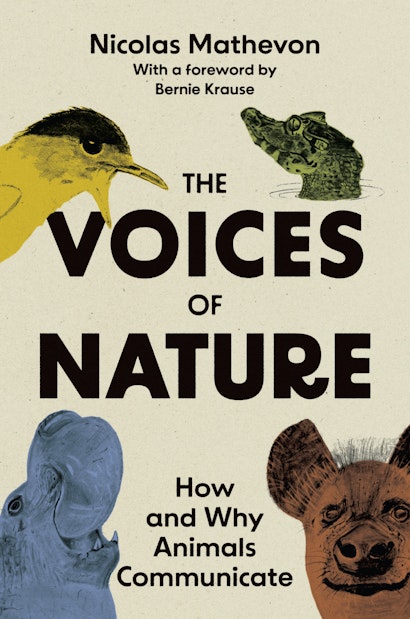Do animals have languages? Bioacoustician Nicolas Mathevon says they do, and The Voices of Nature reveals their mysteries. Taking readers on incredible scientific expeditions to the four corners of the world, this book is a veritable wealth of knowledge, opening up unknown worlds. Did you know that elephant seals recognize each other by voice? That flies emit sounds with their wings to communicate during courtship? That bird nestlings learn their song by imitating an adult? That tits sing at a higher pitch to avoid the noise of cars? And that we can assess an environment by analyzing its soundscapes?
From understanding our own language to developing tools for monitoring biodiversity, bioacoustics is a rapidly expanding field. It needed a book. Both highly joyful and very authoritative, The Voices of Nature is an epic and a mine of discoveries. The world of animal communication is far more incredible than you might think.
What led you to write this book?
NM: Bioacoustics, the study of acoustic communication in animals, is a rapidly expanding field that is of great interest to many. Yet until now, no major book has been devoted to it. After 30 years in the profession, having worked with a wide variety of animals both in the wild and in the laboratory, I felt I was well-positioned to take up the challenge. I decided to write a book that draws from my own scientific adventures and brings readers out into the field with me. The book is based on over 600 references and is accessible to a wide readership, since my experience as a teacher enables me to explain complex concepts with clarity. The book is also a scholarly work; The Voices of Nature is aimed at both the curious layperson and the experienced bioacoustician keen to have a well-documented overview of their discipline.
What is Bioacoustics?
NM: Bioacousticians are working to decipher how animals make and hear sounds, what information is encoded in their sound signals, what this information is used for in their daily lives, and also how their acoustic communication systems have developed over the history of life on earth. Studying the richness and complexity of animal acoustic communication can help us understand how our own communication system works. Bioacousticians are a bit like François Champollion, the French historian who deciphered Egyptian hieroglyphics using the Rosetta Stone, a fragment of a stele where the same text is written in several languages. To decode animal languages, many other methods must be used, but the goal remains the same, to decipher their meaning: the sounds produced by animals are signals carrying information whose meaning we can decipher.
Can animal vocalisations be described as “languages”?
NM: There are actually two sides to this question. The first is: “Can animals express anything other than their current emotions through calls that they have no control over?”. The second is more specific: “Do animals have a language comparable to our spoken language, with rules that allow us to exchange information as we do, through sequences of words and sentences?”. Since we cannot enter a non-human brain, it is complicated to answer the first question. However, the male zebra finch that only responds to its female’s calls in the presence of a paired pair, the bonobo that informs its companions of the presence of food through a series of vocalizations, orcas that adjust their hunting behavior by whistling, or the chacma baboon that responds to the vocalizations of its fellows according to its memory of past events, all suggest that the production of sound signals in animals may be more than an uncontrolled reflex mechanism. Without taking too many leaps of logic, we can therefore affirm that at least some animal vocalizations represent something other than an emotional state expressed in a purely spontaneous manner. Especially in species with complex social lives, where acoustic communications allow individuals to manage their interactions astutely, animals can certainly control all or part of their sound production. So why would we refrain from talking about language then? It is, after all, a convenient term for an acoustic communication system in which the sender produces sounds to send information to the receivers. Yet we must take a precaution and not put all animal species in the same basket. There is not a single animal language. There are in fact as many animal languages as there are animal species that use sounds to communicate. The spoken language of humans is one of them. The non-human languages are more or less complex and follow general rules that are very similar to ours. However, the structure and organization of the sound signals used for communication remain specific to each animal species, including humans.
What are the main applications that Bioacoustics may have in everyday life?
NM: Bioacoustics has many applications in fields as varied as medicine and ecology. For example, the acoustic quality of vocalizations can be used as a marker for neurodegenerative diseases, making it possible to monitor the effectiveness of a particular treatment, both in animal models such as mice and in humans. What we know about the coding of information in the alarm or distress calls of birds and mammals can be used to develop acoustic signals to attract or repel animals. This is how many airports have been able to develop loudspeakers to scare birds away from runways. Bioacoustics is also very useful for monitoring biodiversity, allowing us to identify and count birds or other animals automatically by recording them. This technique is used in the ocean to spot whales, sperm whales and even fish. We can also work on a different scale, considering entire soundscapes as indicators of the animal species living in the same environment. The idea is simple: use bioacoustics to measure biodiversity and assess the condition of an ecosystem. Of course, a soundscape only partially represents the diversity of life. But everything comes together in nature. Where the species of insects and birds producing acoustic signals are diverse and numerous, so are other animals, plants and all other living things. The widespread and ongoing declines in bird populations on Earth can result in changes in soundscape quality.
Do you think Artificial Intelligence can be used to communicate with animals?
NM: Our understanding of animal acoustic communications has always evolved in tandem with the development of techniques: the tape recorder, the computer, mathematical advances in signal analysis, etc. The use of artificial intelligence in bioacoustics is the next decisive and fantastic step. AI will enable us to better understand the communications of animals with complex social lives and large vocal repertoires, such as great apes and whales. However, AI is not magic: it is not just by feeding our computers thousands of sound recordings that AI will be able to explain the language of chimpanzees, mice or other animals. Field biologists need to go out and collect data by observing the animals and recording as much information as possible, such as the contexts in which the vocalizations are emitted, the identity of the sender and receiver individuals, their social links and so on. AI is excellent at extracting information from very large databases, but the information still needs to be present in those databases. Finally, we also need to check that the language organization rules found by the AI are the same as those used by the animals. To do this, we need to “ask them the question” through playback experiments. AI is a fabulous tool for understanding animal languages, but it can never do without biologists with in-depth knowledge of animals. I dream of the moment when AI will allow us to link soundscapes and information exchange processes between individuals. It will then be possible to describe the structure of soundscapes, to quantify the information flows that cross them, and to extract the network of relationships between the levels of organization of an ecosystem. Bioacoustics has already started this transition towards the study of dynamic systems constituted by the assemblages of living beings and their interactions that characterize ecosystems. The exploration of acoustic biodiversity using AI is still in its infancy.
What’s your best memory of working as a bioacoustician?
NM: I have tons of excellent memories, particularly in the field where it’s particularly exciting to gradually understand how an animal communicates. For example, when we realized one day that in the song of the white-browed warbler, a bird of the Brazilian Atlantic forest, the information identity of the species (i.e., “I am a white-browed warbler”) was encoded by an acoustic parameter that was highly resistant to propagation through the forest, whereas the information identity of the individual (i.e., “My name is Peter, Paul or James”), carried by a more fragile parameter, was quickly degraded and could only reach the immediate neighbors. Finding both public and private information in the song of a bird—that was something else! There were also some very exciting moments, such as when a hippo ran towards our loudspeaker, furious at hearing the voice of an individual who did not belong to his group.
What’s the one thing you’d like readers to take away from this book?
NM: Just how fascinating and infinite is the exploration of animal languages, for the novice as well as for the expert in bioacoustics! May The Voices of Nature give readers a taste for science, especially young people. Motivating the younger generation to ask questions about the world around them, putting aside all dogma and adopting a rational approach based solely on the facts, is a duty for any scientist concerned about our freedom of thought and the future of our planet.
Nicolas Mathevon is Distinguished Professor of Neurosciences and Animal Behavior at the University of Saint-Etienne, senior member of the Institut universitaire de France, member of Academia Europaea, and president of the International Bioacoustics Society. He is also a former visiting Miller Professor at the University of California, Berkeley, and a former visiting professor at Hunter College, City University of New York.

